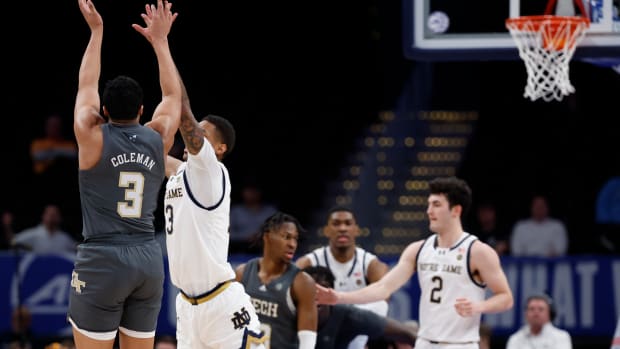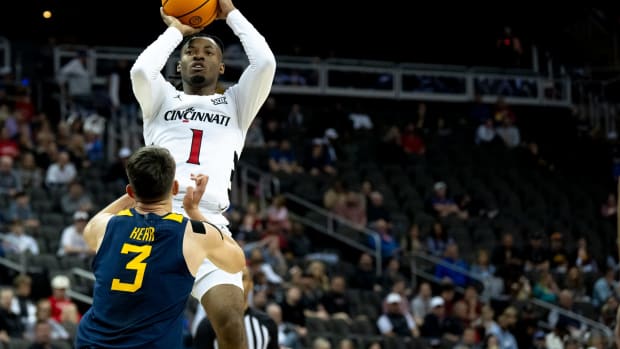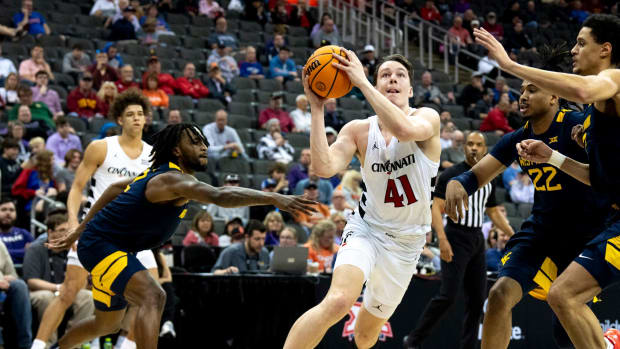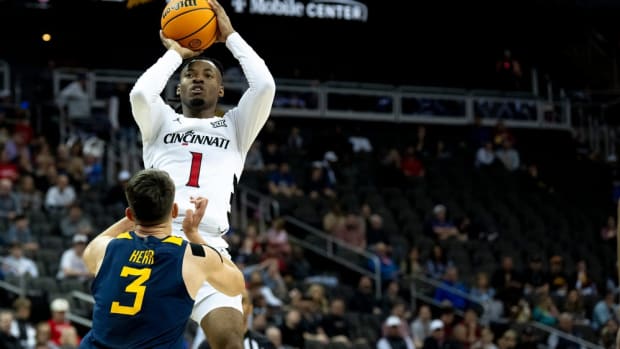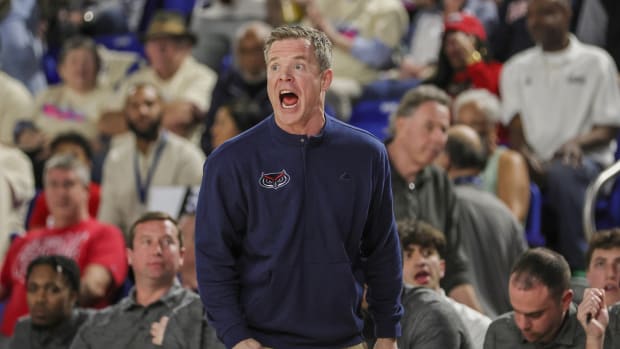Big East relying on Villanova to legitimize reconstructed league
Get all of Brian Hamilton’s columns as soon as they’re published. Download the new Sports Illustrated app (iOS or Android) and personalize your experience by following your favorite teams and SI writers.
HOUSTON — The question Sunday regarded all the nice things people in the Big East Conference said about Villanova after its record-breaking win in a Final Four semifinal, which meant it was just another layup to convert this weekend. So Jay Wright, the Wildcats’ head coach, talked about the great relationship all the league’s coaches have with each other, the text message threads they have come tournament time, the connection they have as basketball coaches in a college sports landscape thoroughly dominated by football. “We feel like we need each other,” Wright said. “We all need to be good.”
That might be true, but it’s also generous. The reconstructed and somewhat retrofitted Big East mostly needed Villanova to be this good, to be in the national championship game and to thus validate the plan. That’s certainly the attitude within the league: There was an urgency to prove that basketball could be played at a high level without football resources. And anyone could have done it, of course. But it was always likeliest that the Wildcats would. No one in this conference of private religious institutions was clutching rosary beads in one hand and the hope that St. John’s or DePaul would carry the banner in the other.
Wright said that nothing much changes for Villanova if it beats North Carolina on Monday at NRG Stadium, and he might be right. But a good deal changes for the league his team is in. The Wildcats’ presence in the Final Four was a rejoinder to the idea that a tiny basketball league wouldn’t matter. A victory over a national Goliath would drive a stake through the idea.
“For our league it is special—we had great confidence in this plan, and we did believe we could be nationally competitive and ultimately win a national championship with this configuration of schools,” commissioner Val Ackerman said Sunday. “To see it happening so quickly, it’s tremendous.
Hyper-focused Villanova exacts revenge in historic Final Four win
“We know the Big East is different,” she continued. “We’re well aware. We know. We know this isn’t the same Big East as the one that played in 1985, 1990, or 1995. We know. But we still think it can be a great league because we have the ingredients to keep it a great league. Win, lose or draw, we’re going to walk away feeling like this season put us ahead of plan.”
Villanova was simply the program best equipped to execute the plan from the start, and should it hoist a trophy amid a confetti shower late Monday, there’s an interesting discussion to be had about sticking to that plan.
Creighton athletic director Bruce Rasmussen was quoted by Kansas.com in late March as being a proponent of adding Wichita State and Gonzaga to the 10-team league. Rasmussen noted that he didn’t sense a “great appetite” for expansion from the league’s presidents, which is a crucial distinction, since it’s the league’s presidents who will make that call. And those league presidents evidently aren’t inclined to be swayed by the opinion of one constituent athletic director. “There’s nothing cooking,” Ackerman said. “Our guys love 10. That’s it.”
• ROSENBERG: UNC, Villanova have different expectations in title game
The scenario of a Villanova championship, considered alongside Xavier earning a No. 2 seed this year and potentially returning a roster worthy of national title contention next year, suggests there’s no compelling competitive reason to stretch the league’s already cumbersome geography and bring aboard others who might help with the breakthrough.
Surely other considerations, in the form of television contract dollars, would drive that decision. But a Villanova win would enhance a national profile while, maybe, mitigating any impulse to do so by scheduling an awkward Providence at Gonzaga game in mid-February. “A lot of boxes would have to get checked off for a team to be invited into the Big East at this point,” Ackerman said.
Three things to watch for in the national championship game
In its three years of its new existence, the Big East has earned 15 NCAA tournament bids—on average, half the league each season. Those 15 invites have gone to eight different teams. Its conference RPI was second nationally in 2014–15 and fourth in 2015–16, ahead of the Big Ten and the SEC this season. This is no middling league scrounging for the smallest morsels of success.
But regular-season success and earning a bunch of tournament bids goes only so far. There’s no denying the perception boost that accompanies a national championship run. The Big East may need all of its teams to be good. But if we’re being realistic, it counted on one team to be this good.
Asked about the benefits of having a strong lead dog, Ackerman said she’d prefer a “dog team.” But you have to start somewhere. And starting with quality at the top is ideal. “We’re finding our place,” Wright said of his league. “The new Big East, we’re not trying to say we’re the best conference in the country, but we are trying to say … during basketball season, we are a basketball conference, and let’s do our best to fit in.”
They don’t all need to be good to find that fit. They just need one team to finish the job Monday.
